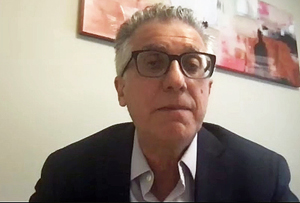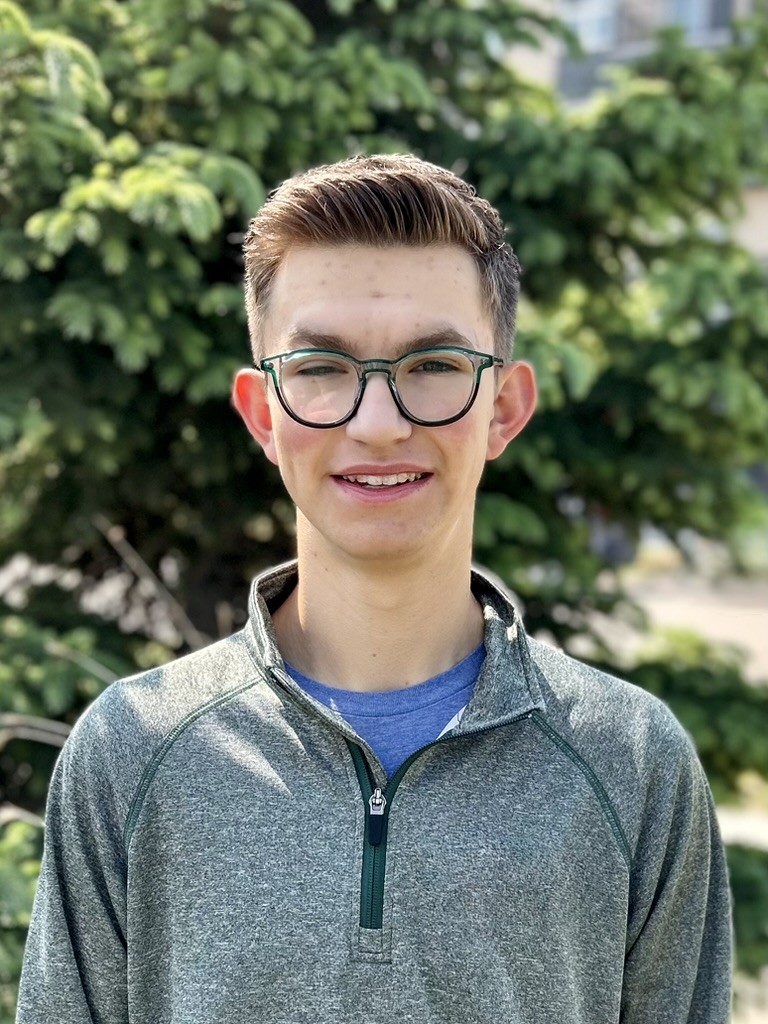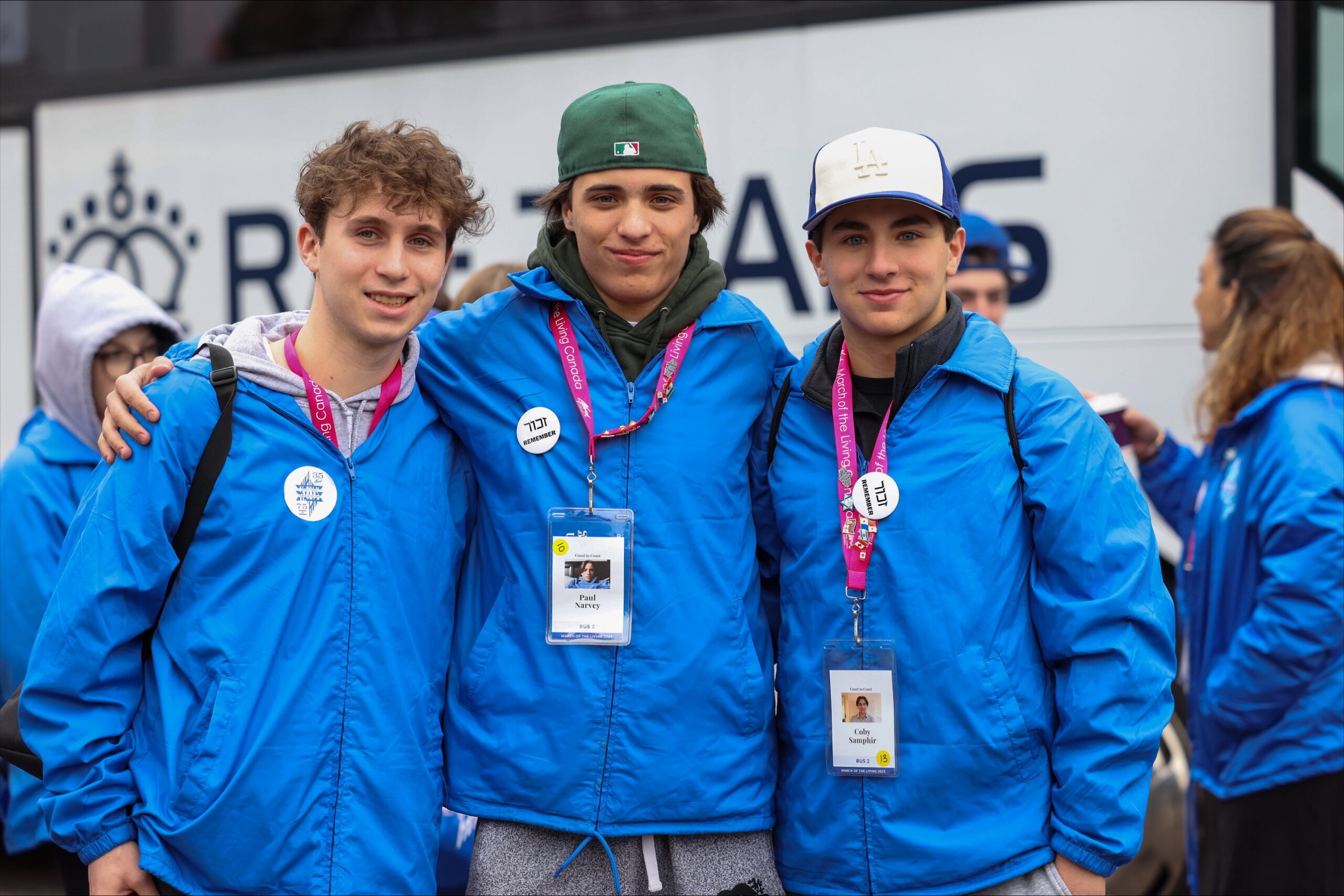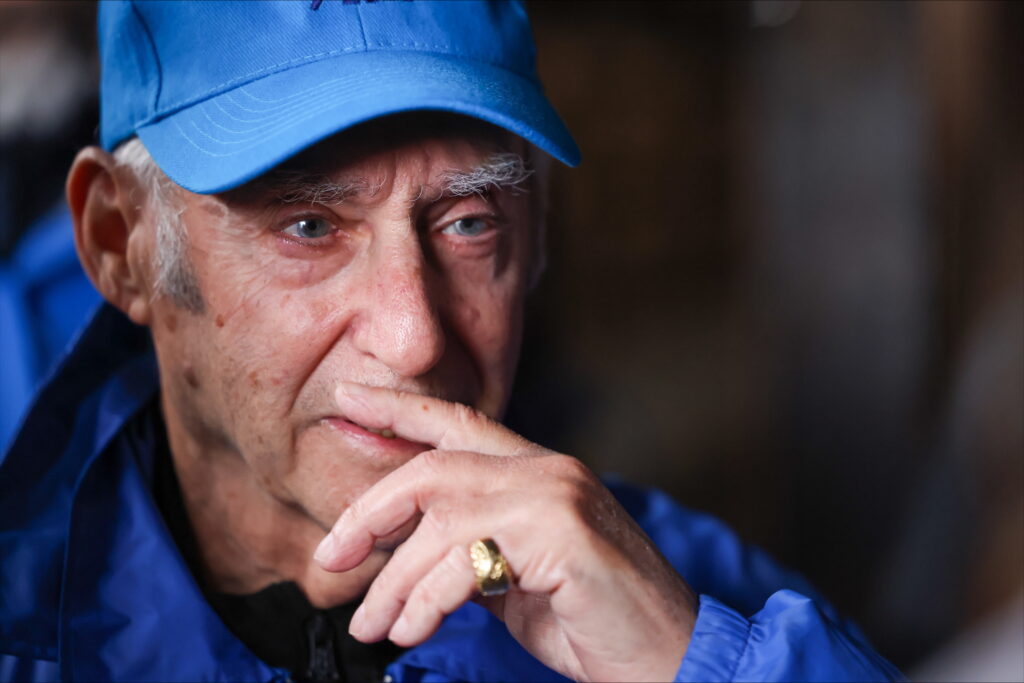Local News
At Limmud: New University of Manitoba president Michael Benarroch speaks of the challenges presented by stepping into his role in midst of a pandemic

By BERNIE BELLAN While there were a great many interesting speakers at this year’s Limmud, the one speaker to whom I was looking most forward to hearing was Michael Benarroch, the new president of the University of Manitoba.
Since returning to Winnipeg last summer after having served as the provost and vice-president of Ryerson University in Toronto since the fall of 2017, Benarroch was thrust headlong into having to take over his position in the midst of a pandemic.
Naturally, there haven’t been many opportunities to see and hear Benarroch, nor to interview him since he returned to Winnipeg, so his appearing at Limmud allowed Limmud participants the chance to hear directly from a man whose career has seen him move steadily up the academic administration ladder in the past 30 years.
At times wistful – in speaking of his family’s having come here from Morocco, at other times contemplative, in discussing how important it is to include Indigenous students and faculty in reshaping the U of M, Benarroch told a story – of how he’s arrived at his present situation in life and what his goals are looking forward.
“My parents never had the opportunity to go to university,” Benarroch explained at the outset of his presentation.
“My family came to Winnipeg (from Morocco) because my mother’s brother was in Winnipeg. My father was a teacher, but when he came to Winnipeg he found a job as a shochet,” Benarroch said.
It was while he was an undergrad at the University of Winnipeg that Benarroch said he developed a “passion for economics”. He later went on to acquire a PhD in Economics from Carleton University – in 1992.
Upon completing his PhD Benarroch returned to the University of Winnipeg. At the time, he explained during his presentation, Lloyd Axworthy was President of the University of Winnipeg and Axworthy asked Benarroch whether the university should have a business school?
“I designed a vision,” Benarroch said, and eventually he became dean of the new Faculty of Business and Economics.
After 19 years at the U of W, Benarroch said he “interviewed for Dean at the Asper School of Business” at the University of Manitoba, which he became in 2011.
“The University of Manitoba is one of 50 research intensive universities in Canada,” Benarroch noted – something that was to prove a factor in his wanting to return here this past year.
In 2017, Benarroch became Provost and Vice-President Academic at Ryerson University.
For Benarroch, Ryerson was a good fit, he explained, because “it had a real focus on community engagement and entrepreneurship.”
As for moving to Toronto, Benarroch admitted that he and his wife, Kim (Bailey), “missed Winnipeg a lot – especially Kim.” Still, by the time they left Toronto this past summer, both their sons (Keenan and Aden) had also moved to Toronto, so returning to Winnipeg was a bit of a mixed blessing for Michael and Kim.
The story how Benarroch came to be president of the University of Manitoba is an interesting one.
When he applied for the position – in 2019, “I didn’t even tell my family I was applying,” he said. And, when he came to Winnipeg to interview for the position, he didn’t even tell his brothers he was here. (Al Benarroch is Executive Director of Jewish Child and Family Service, while Yosef Benarroch is Rabbi of the Adas Yeshurun Herzlia Congregation, although he also lives part of the year in Israel – during normal times. A fourth brother, Yamin, who is also a rabbi, lives in Vancouver).
Ultimately, Benarroch “was offered the position of president (of the U of M) in 2019,” he said, “then Covid hit and turned everything topsy turvy.”
At that point, the host of this particular Limmud session, Faye Rosenberg Cohen, asked Benarroch: “Did you plan out the career part?”
Benarroch responded: “I knew the presidency at the University of Manitoba was coming up. I kept my eye on it, but I thought that (moving to Toronto) was going to be my last move.
“There had to be a good reason for me to move from one institution to another.
“During my time at the Asper School I thought though that I really meshed well with the atmosphere at the University of Manitoba.”
As for Ryerson, Benarroch noted that the school began as a polytechnic institute and it still carries a very large imprint as a technical training school even though it is now a university.
“Ninety-five percent of the students have an experiential background – serving in apprenticeships” and work programs, while attending classes, Benarroch explained.
Part of Benarroch’s mandate while he was at Ryerson, he noted, was to “rebuild the faculty.”
“We went from 700 to over 900 in the three years I was there,” Benarroch stated.
“We hired quite a few younger academics who brought a lot of energy with them,” he added.
Another major change that Benarroch said he helped to foster was a concerted effort to hire more Indigenous instructors.
“When I arrived there were only six Indigenous professors at Ryerson,” he observed.
“Working with students and elders we launched a reconciliation process. We made Ryerson a place where Indigenous people would feel welcome,” including by “hiring 20 new Indigenous staff,” Benarroch said.
“We also brought in a fair bit of scholarship money for Indigenous students,” he added.
Yet, when the opportunity to take over as president of the University of Manitoba presented itself, Benarroch noted, that despite his having fit in well at Ryerson, he said that “you never want to leave a job, but if I hadn’t taken that opportunity I don’t think it would have come up again.”
Rosenberg Cohen asked Benarroch “How has being a religious Jew worked for you, first as a professor, then as an administrator?”
Benarroch replied: “As a prof, it was great. As an observant Jew I was always able to schedule my time so as to be able to observe Shabbat.”
Benarroch mentioned that one of the two sabbatical years he took as a professor was at the University of Haifa, which was of particular significance for him – being able to spend the year in Israel.
However, upon becoming an administrator, Benarroch suggested, “my schedule was not mine as much as it was in the past…At Ryerson, the president was an observant Muslim, so I always I had to make sure I was on campus on Fridays while he was attending prayers.”
Further, Benarroch noted, while the advent of Zoom during the pandemic has certainly enabled teaching and meetings to carry on, Zoom has, in fact, “made it harder to remain Shabbat observant.”
Prior to the pandemic, he explained, if he had a meeting or conference to attend – even on a Shabbat, “I would be staying in a hotel and I could attend a meeting – without taking any notes.”
Now, it’s impossible to participate in a Zoom session during Shabbat, he said – and since the workday seems to have expanded to include almost any hour of the day, Benarroch admitted that, as much as technology has allowed meetings to be held relatively easily, it has presented problems for him having to decide between his obligations as a university president and his religious observance.
As for some of the other more noticeable effects that the pandemic has had on his role as president at the U of M, Benarroch said: “I have four staff members in my office; I’ve seen one of them in person.”
Benarroch told the Limmud audience that, prior to assuming his new role, he read a book offering advice on “how to be a university president”.
(Rosenberg Cohen asked the question that was probably on everyone else’s minds at that point: Are there enough people in the world who would be in the position that they were interested in becoming a university president that it would be worth it to write a book about that subject?)
In any event, Benarroch said that this particular book did offer two really good pieces of advice:
1. Don’t make a major decision during your first six months in the new position;
and 2. Go out and meet as many people as you can off the bat.
(Obviously, the second piece of advice was thrown out the window when Benarroch returned to Winnipeg during the pandemic.)
In terms of how the pandemic will change the way university courses are taught even following the pandemic, Benarroch suggested that what is likely to occur is that professors will teach classes where some students attend in person while other students will take those same classes online.
“We’re also looking to have classes for Indigenous students up north” offered online, following on the success of Zoom teaching during the pandemic, he suggested.
While “there has been a lot of resistance to teaching online among academics,” Benarroch admitted, “students have been adapting.”
With reference to how many students are actually enrolled at the university this academic year, Benarroch observed that, while there are “fewer first year students at the University of Manitoba, there have been more students return for second, third, and fourth year” than in previous years.
“Enrolment is definitely up,” Benarroch said, “and we expect to see the majority of students return again in the fall.”
Rosenberg Cohen asked: “If I were a parent, thinking of spending money to send my child to a university somewhere, why would I spend all that money when they can take their classes online?”
Benarroch’s response was that, while virtual classes will certainly be a major part of whatever format universities eventually evolve into becoming, there is going to be a greater emphasis on “more participation, more research, more experiential. There are going to be more opportunities outside the classroom”, but they are going to be in person, not online.
As an example, Benarroch said he’s planning on creating a “student start-up zone”, in which students will start their own businesses.”
“It’s better to fail at a business when you’re 23 than when you’re 55,” Benarroch observed.
Rosenberg Cohen asked: “What are your hopes and dreams?”
Benarroch said, “Here at the University of Manitoba we have a tremendous testing capacity. Winnipeg could become a testing centre for vaccines,” for instance he suggested.
Continuing on the thread of what his hopes and dreams are, Benarroch said: “I’d like to see the University of Manitoba become a global leader in certain areas.
“I’d like to see the university become a racist-free zone.” (He noted that the previous president of the U of M, David Barnard, “had launched a task force on Equality, Diversity, and Integration.)
“We know we can’t stamp out racism, on campus,” Benarroch observed. “The question is how to deal with it.”
Someone in the Zoom audience wondered how one can maintain a balance between stamping out racism while still allowing free speech?
“We’re still a university. We are going to have debate and disagreement,” Benarroch said in response.
Someone else wondered “How does the university compensate for lab work that can’t get done?
Benarroch answered that “We allow 20 percent capacity in some spaces…We’ve also developed a way to hold some of the labs virtually.”
As well, Benarroch said that, for ten days in January, students in the Faculties of Nursing, Science, Architecture, Engineering, and Agriculture, were allowed back on to campus” to conduct lab work – under strict Covid protocols.
I asked a question along these lines (although the names of questioners were not given): Professors are having to spend more time than ever before finding funding for their programs. With the emphasis on practical, results-oriented programs, where will that leave programs that don’t necessarily have practical applications? (My question was not worded precisely that way, but it was along those general lines.)
Benarroch’s response was that “the university brings in just under $200 million a year in research money – the vast majority of which comes from the federal government.”
He added that he has two goals as far as where the money for research goes: to allow students who were doing research prior to Covid to continue doing that work; and to obtain additional money to keep university labs running.
Benarroch also noted that there is now a “massive reinvestment in science in the US. We have to remain competitive in how we pay faculty and how we keep up our labs.”
It seems quite evident, therefore, that Michael Benarroch is going to be preoccupied with finding ever new sources of funding for the university, while trying to retain whatever sources have been in place until now.
It seemed fitting, therefore, that one of his final observations was that “one of my mandates as president is to speak to government”.
Still, lost in all the discussion about funding and research was any reference to the less practical aspects of a university education. Of course, that’s a subject that’s been debated for a very long time. I just wonder where faculties such as Arts are going to end up with the even greater emphasis on “research” oriented programs.
Local News
Further to the Simkin Centre’s financial situation

By BERNIE BELLAN A while back I published an article about the deficit situation at the Simkin Centre. (You can read it at “Simkin Centre deficit situation.“) I was prompted to write that particular article after reading a piece written by Free Press Faith writer John Longhurst in the August 5 issue of the Free Press about the dire situation personal care homes in Winnipeg are in when it comes to trying to provide their residents with decent food.
Yet, Longhurst made one very serious mistake in his article when he wrote that the “provincial government, through the Winnipeg Regional Health Authority, has not increased the amount of funding it provides for care-home residents in Manitoba since 2009.”
In fact, the WRHA has given annual increases to personal care homes, but its allocations are not broken down by categories, such as food or salaries. As a spokesperson for the WRHA explained to me in an email: “PCHs receive per diem global operating funding based on the number of licensed beds they operate. This funding model is designed to support the full range of operating costs associated with resident care, including staffing, food services, utilities, building operations, and other day-to-day expenses.”
Now, one can make a perfectly valid argument that the level of funding from the WRHA has not kept up with inflation, especially inflation in food costs, but the Simkin Centre is in an even more precarious position because of the skyrocketing cost of kosher food.
“In recent years,” according to an article on the internet, “the cost of kosher food has increased significantly, often outpacing general food inflation due to unique supply chain pressures and specialized production requirements.”
Yet, when I asked Laurie Cerqueti how much maintaining a kosher facility has cost the Simkin Centre, as I noted in my previous article about the deficit situation at Simkin, she responded: “approximately $300,000 of our deficit was due to food services. I do not have a specific number as far as how much of the deficit is a result of kosher food…So really this is not a kosher food issue as much is it is an inflation and funding issue.”
One reader, however, after having read my article about the deficit situation at Simkin, had this to say: “In John Longhurst’s article on Aug 5, 2025 in the Free Press, Laurie (Cerqueti) was quoted as saying that the annual kosher meal costs at Simkin were $6070 per resident. At Bethania nursing home in 2023, the non-kosher meal costs in 2023 were quoted as $4056 per resident per year. Even allowing for a 15% increase for inflation over 2 years, the non-kosher food costs there would be $4664.40 or 24% lower than Simkin’s annual current kosher food costs. If Simkin served non-kosher food to 150 of its 200 residents and kosher food to half of its Jewish residents who wish to keep kosher, by my calculation it would save approximately $200,000/year. If all of Simkin’s Jewish residents wished to keep kosher, the annual savings would be slightly less at $141,000.”
But – let’s be honest: Even though many Jewish nursing homes in the US have adopted exactly that model of food service – where kosher food is available to those residents who would want it, otherwise the food served would be nonkosher, it appears that keeping Simkin kosher – even though 45% of its residents aren’t even Jewish – is a “sacred cow” (pun intended.)
So, if Simkin must remain kosher – even though maintaining it as a kosher facility is only adding to its accumulated deficit situation – which currently stands at $779,426 as of March 31, 2025,I wondered whether there were some other ways Simkin could address its deficit while still remaining kosher.
In response to my asking her how Simkin proposes to deal with its deficit situation, Laurie Cerqueti wrote: “There are other homes in worse financial position than us. There are 2 homes I am aware of that are in the process of handing over the keys to the WRHA as they are no longer financially sustainable.”
I wondered though, whether the Simkin Centre Foundation, which is managed by the Jewish Foundation of Manitoba might not be able to help the Simkin Centre reduce its deficit. According to the Jewish Foundation’s 2024 annual report, The Saul and Claribel Simkin Centre Foundation, which is managed by the Jewish Foundation, had a total value of $11,017,635.
The Jewish Foundation did distribute $565,078 to the Simkin Centre in 2024, but even so, I wondered whether it might be able to distribute more.
According to John Diamond, CEO of the Jewish Foundation, however, the bylaws of the Foundation dictate that no more than 5% of the value of a particular fund be distributed in any one year. There is one distinguishing characteristic about the Saul and Claribel Simkin Centre Foundation, in that a portion of their fund is “encroachable.” The encroachable capital is not owned by JFM. It is held in trust by JFM but is beneficially owned by Simkin, similar to a “bank deposit”. While held by the JFM, these funds are included in the calculation of Simkin’s annual distribution.
I asked John Diamond whether any consideration had been given to increasing the distribution that the Jewish Foundation could make to the Simkin Centre above the 5% limit that would normally apply to a particular fund under the Foundation’s management.
Here is what John wrote in response: “The Simkin does have an encroachable fund. That means that at their request, they can encroach on the capital of that fund only (with restrictions). This encroachment is not an increased distribution; rather, it represents a return of capital that also negatively affects the endowment’s future distributions.
”It is strongly recommended that encroachable funds not be used for operating expenses. If you encroach and spend the capital, the organization will receive fewer distribution dollars in the next year and every year as the capital base erodes. Therefore, the intent of encroachable funds is for capital projects, not recurring expenses.”
I asked Laurie Cerqueti whether there might be some consideration given to asking for an “encroachment” into the capital within the Saul and Claribel Simkin Centre Foundation?
She responded: “We are not in a position where we are needing to dip into the encroachable part of our endowment fund. Both of our Boards (the Simkin Centre board and the Saul and Claribel Simkin Centre Foundation board) are aware of our financial situation and we are all working together to move forward in a sustainable way.”
At the same time though, I wondered where donations to the Simkin Centre end up? Do they all end up in the Simkin Centre Foundation, for instance, I asked Laurie Cerqueti on December 15.
Her response back then was: “All donations go through our Foundation.”
I was somewhat surprised to read that answer, so I asked a follow-up question for clarification: “Do all donations made to the Simkin Centre end up in the Simkin Centre Foundation at the Jewish Foundation?”
The response this time was: “No they do not.”
So, I asked: “So, how do you decide which donations end up at the Foundation? Is there a formula?”
Laurie’s response was: “We have a mechanism in place for this and it is an internal matter.”
Finally, I asked how then, the Simkin Centre was financing its accumulated deficit? Was it through a “line of credit with a bank?” I wondered.
To date, I have yet to receive a response to that question. I admit that I am puzzled that a personal care home which has a sizeable foundation supporting it would not want to dip into the capital of that foundation when it is facing a financial predicament. Yes, I can see wanting the value of the foundation to grow – but that’s for the future. I don’t know whether I’d call a $779,425 deficit a crisis; that’s for others to determine, but it seems pretty serious to me.
One area that I didn’t even touch upon in this article, though – and it’s something I’ve written about time and time again, is the quality of the food at the Simkin Centre.
To end this, I’ll refer to a quote Laurie Cerqueti gave to John Longhurst when he wrote his article about the problems personal care homes in Winnipeg are facing: “When it comes to her food budget, ‘we can’t keep making the same number of bricks with less straw.’ “
Local News
Exclusive: Security Enhancement Fund to be announced by Province in coming days

By NOAH STRAUSS The province is set to announce a new program called the Security Enhancement Fund, which
will provide funding to religious and faith groups to improve security at institutions such as
synagogues and mosques. In an exclusive interview, Minister of Justice Matt Wiebe outlined the
plan and detailed what the province has already done to help protect Jewish Manitobans.
“What we want to do is to be able to provide the community with the kind of tools that they need
to stay safe and to ensure that everyone in the community feels safe,” said Wiebe.
The fund will provide a missing link between government and religious communities, and
communities will now be able to make their own choices without money being a big restraint.
Essentially, the power will be in the hands of community leaders and not government officials.
The minister noted that the new partnerships will provide the province a better understanding of
the needs of every community. Rather than the province making the choices, they are
essentially giving a voice to each community. The grants, totalling $1 million, will provide funds to enhance security at facilities like synagogues.
The Jewish Post reached out to Dr. Rena Secter Elbaze, executive director of Congregation
Shaarey Zedek. “It’s important that the government show us that they’re taking security seriously and stepping up to the plate to make this offer. We will absolutely be applying for grant money,” she said. Elbaze also wants to know whether or not the government will cover the costs of things the synagogue has already spent money on. She noted that the province has, in the past, made grants available to have security guards present.
When speaking about what the Justice Ministry has already done to protect Jewish Manitobans,
Wiebe brought up the new special prosecutor that is focusing on hate crimes. Wiebe said the
special prosecutor works closely with the Winnipeg Police Service “to support investigations and
prosecute hate crimes. Wiebe also went on to say how the Department of Education has been helping to fight antisemitism. “The creation of the Holocaust education curriculum is an important step in the right direction,” he said. When asked about Oliver Didtger Ederhof, the individual charged with 14 counts of mischief including vandalism of Shaarey Zedek, Wiebe said decisions like bail and police undertakings are decisions that are in part made by the federal government through the criminal code and policies. “We’re going to continue to advocate for stricter bail reform at the federal level…. I’ve been very clear, we issued clarified directives around bail to our Crown prosecutors.”
The full announcement from the province is expected in the coming days.
Local News
March of the Living 2023 participants form Taste of Hope project to help honour the memory of Holocaust survivor Alex Buckman

By BERNIE BELLAN The March of the Living is an annual two-week international educational program that brings thousands of students and adults to Poland and Israel to study the Holocaust, Jewish history, and the rise of the State of Israel. Founded in 1988, it features a 3-kilometer silent walk from Auschwitz to Birkenau on Yom HaShoah (Holocaust Remembrance Day).
Attendees on the march are accompanied by adults, some of whom themselves have been Holocaust survivors.
Following the week in Poland, participants travel to Israel to observe Yom HaZikaron (Israel’s Memorial Day) and celebrate Yom HaAtzmaut (Israel’s Independence Day), marking a journey from darkness to life.
For many years the coordinator of the march in Winnipeg was Roberta Malam, working on behalf of the Jewish Federation of Winnipeg. More recently Abby Flackman filled that role, and now the person in charge is Lindsey Kerr.
Since its inception 37 years ago the March of the Living has become a rite of passage for many young Winnipeg Jews who have been able to participate as an organized group from Winnipeg and combine visits to the death camp at Auschwitz-Birkenau in Poland with the subsequent trip to Israel.
Then – the Covid pandemic hit – in 2020, and the March of the Living was put on hold for two years – in 2020 and 2021.
In 2022, the March of the Living resumed, but there was no organized contingent from Winnipeg participating. (There may have been some Winnipeggers who did go on the march that year, but if there were any they would have been part of a general Canadian group since there was no Winnipeg coordinator that year.)
In 2023, however, once again a very large contingent of young Canadian Jews – 51 altogether, of whom approximately two-thirds were from Winnipeg, went on that year’s March of the Living. That particular march was memorable for many reasons, including the fact it was the last full march since 2019 and was to remain the last march to have an organized Winnipeg contingent in the past six years as the years 2024 and 2025 were interrupted by the war in Gaza. (There were smaller marches held in 2024 and 2025, but again there was no organized contingent from Winnipeg.)
Recently, we were contacted by one of the participants of that 2023 march, Ethan Levene, who asked us whether we’d be interested in running what turned out be a very poignant story about one particular aspect of that 2023 March of the Living.
Here is what Ethan wrote:
“In April 2023, the Coast to Coast Canadian delegation of March of the Living was privileged to travel with Holocaust survivor Alex Buckman (z”l). March of the Living is a Holocaust education trip that allows participants to visit and bear witness to the sites of the Holocaust. Unfortunately, while sharing his story in Poland, Alex passed away. However, the impact he left on us students was immeasurable.

“While speaking to us in Warsaw, Alex told us the story of his Aunt Becky’s gâteau à l’orange (orange cake). While in Ravensbruck concentration camp, his aunt managed to write down this recipe. After his parents’ murder, his Aunt Becky went on to raise Alex after surviving. In addition to sharing his story, Alex tasked us with baking the cake with family and friends.
“Out of this, a group of alumni from our trip have created this project: ‘A Taste of Hope.’ On February 1st, university students from over 5 universities across Canada will come together to bake the gâteau à l’orange and hear Alex’s story. Proceeds from the event and this fundraising page will support the World Federation of Jewish Holocaust Survivors and Descendants. Alex was heavily involved with this organization, whose mission is to both create community for Holocaust survivors and their descendants and educate about the Holocaust to help fight against antisemitism and all forms of bigotry and hate.
“Here is information from our fundraising page for the event – ‘A Taste of Hope’: Fundraising for A Taste of Hope.
Ethan added that “it’s completely student led, all by alumni from our 2023 trip attending university at these various locations across Canada; Winnipeg, London, Kingston, Montreal.”
He also added: “Follow us on instagram@tastehope.“
Here is a link to a CBC story about Alex Buckman: Alex Buckman story
In a subsequent email Ethan gave the names of Winnipeggers who are involved in A Taste of Hope: Ethan Levene (studies at McGill), Zahra Slutchuk, Alex Stoller (studies at Queens), Coby Samphir, Izzy Silver (studies at Waterloo).
He also added names of others who are involved in the project: Jessie Ages, Anneke Goodwin, Lilah Silver, Ella Pertman, Ellie Vogel, and Talia Cherun.
To find out more about March of the Living in Winnipeg go to: March of the Living


